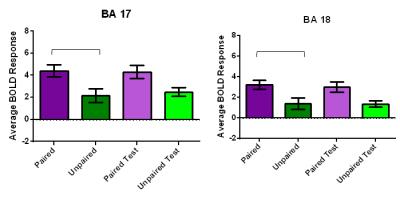1728
The intrinsic functional mechanism for olfactory-visual association in the human brain as quantified by fMRI1Radiology, Penn State University, Hershey, PA, United States, 2Radiology, Nanjing University Medical School, Nanjing, People's Republic of China
Synopsis
The purpose of this study was to elucidate the reciprocal effect of olfactory-visual associations on olfactory and visual processing in the human brain using fMRI. Young, cognitively healthy participants underwent 3 separate olfactory-visual association paradigms, including either neutral, semantically congruent, or semantically incongruent visual cues. The data revealed significant olfactory activation in the POC and visual areas in response to visual cues, regardless of semantic meaning (neutral, congruent, or incongruent). This reciprocally increased activation in the POC and visual cortex during olfactory-visual cue pairing and subsequent visual cue presentations may suggest an intrinsic functional mechanism for multisensory associative learning.
Purpose
Since human perception is predominately dependent on visual information, it is critical that an understanding is generated of how vision interacts with other sensory systems, specifically olfaction, in the brain1-5. A recent fMRI study in our lab has suggested that an olfactory-visual association can be formed in the human brain by a single pairing of an odor and visual cue6. The mechanism of such rapid olfactory-visual association is unclear, however. Therefore, the purpose of this study was to elucidate the reciprocal effect of olfactory-visual associations on olfactory and visual processing in the human brain using fMRI.Methods
Young, cognitively healthy participants (n=12, age = 25.7 + 3.8 years, 4 males) underwent 3 separate olfactory-visual association paradigms, including either neutral, semantically congruent, or semantically incongruent visual cues, on a 3T Siemens Prisma system with a 20 channel head coil with an EPI (GE) sequence for functional data acquisition (T2 = 2000 ms, TE = 30 ms, FA = 90°, FOV = 230 x 230 mm2). Figure 1 illustrates the neutral symbol paradigm as an example of the timing and procedure of all the paradigms. During the neutral symbol paradigm, Chinese characters, which are presumed to carry no inherent semantic meaning for native English speakers, were used as neutral symbols. The semantic congruent paradigm consisted of pairing the visual cue “Smell” with an odor and the visual cue “Look” alone, whereas the semantic incongruent paradigm involved the opposite, with “Look” being paired with an odor and “Smell” presented alone. SPM 8 was used to analyze the fMRI data, while the SPM extension MarsBaR was used to extract BOLD response values for each condition from the target regions of interest (ROIs). The ROIs included the primary olfactory cortex (POC), the primary visual cortex, visual association cortices, the hippocampus, the insula, the orbitofrontal cortex, and the dorsolateral prefrontal cortex.Results
Voxel-based analysis revealed a trend of significant olfactory activation in the POC in response to visual cues, regardless of semantic meaning (neutral, congruent, or incongruent) (Figure 2). Reciprocally, greater activation in both the primary and association visual cortices was observed in response to pairings of a visual cue with an odor, as well as in response to the visual-only cues that were previously paired with an odor during both the neutral symbol and semantic congruent paradigms (Figure 3). This finding was corroborated by ROI-based analysis of the semantic congruent paradigm, which also demonstrated greater visual activation during these conditions (Figure 4).Discussion
The results of this study provide strong evidence that the formation of olfactory-visual associations in the human brain is reciprocal and rapid. It is likely that such co-activation established with a single paring of an odor and a visual cue could be an innate neuro-functional substrate for associative learning that requires further reinforcement and consolidation with repetitive pairings of stimuli. Olfactory stimuli are known to be particularly effective in associative learning and memory recall. Specifically, in conditions where there was multisensory input from both olfactory and visual stimuli, visual activation was significantly enhanced. Furthermore, following formation of the olfactory-visual associations occurring during the acquisition phase, this enhanced visual activation was also seen when the visual cue that was previously paired with an odor was presented alone during the test phase. This suggested the involvement of the visual cortex in formation of associative learning and, perhaps, memory during the olfactory-visual association paradigm.Conclusion
The results revealed a reciprocally increased activation in the POC and visual cortex during olfactory-visual cue pairing and subsequent visual-only cue presentations. Our findings may suggest an intrinsic functional mechanism for multisensory associative learning.Acknowledgements
No acknowledgement found.References
1. Cain WS, Gent JF, Goodspeed RB, Leonard G. Evaluation of olfactory dysfunction in the Connecticut Chemosensory Clinical Research Center. Laryngoscope. 1988 Jan;98(1):83-8.
2. Gottfried JA, Dolan RJ. The nose smells what the eye sees: crossmodal visual facilitation of human olfactory perception. Neuron. 2003 Jul;39(2):375-86.
3. Guerdoux E, Trouillet R, Brouillet D. Olfactory-visual congruence effects stable across ages: yellow is warmer when it is pleasantly lemony. Atten Percept Psychophys. 2014 Jul;76(5):1280-6.
4. Morrot G, Brochet F, Dubourdieu D. The color of odors. Brain Lang. 2001 Nov;79(2):309-20.
5. Grigor J, Van Toller S, Behan J, Richardson A. The effect of odour priming on long latency visual evoked potentials of matching and mismatching objects. Chem Senses. 1999 Apr;24(2):137-44.
6. Karunanayaka PR, Wilson DA, Vasavada M, et al. Rapidly acquired multisensory association in the olfactory cortex. Brain and Behavior. 2015;5(11):1-14.
Figures



